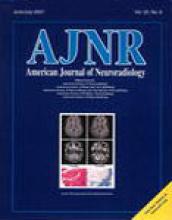Abstract
BACKGROUND AND PURPOSE: Perfusion and diffusion-weighted MR imaging are powerful new imaging techniques for evaluating tissue pathophysiology in association with many neurologic disorders, such as neurodegenerative diseases. The purpose of our study was to evaluate the sensitivity and specificity of dynamic susceptibility contrast-enhanced MR imaging and diffusion-weighted MR imaging in cases of Alzheimer's disease and to assess the role of atrophy in the quantification of cortical perfusion.
METHODS: Thirty-nine participants were studied: 18 patients with moderate cognitive impairment with probable Alzheimer's disease, 16 patients with mild impairment with possible or probable Alzheimer's disease, and 15 group-matched elderly healthy comparison volunteers. Relative values of temporoparietal, sensorimotor, and hippocampal regional cerebral blood volume (rCBV) were measured as a percentage of cerebellar rCBV, and group classification was assessed with logistic regression. Brain atrophy was used as a covariate to assess its role in rCBV quantification. Regions of interest placed on orientation-independent apparent diffusion coefficient maps allowed the calculation of apparent diffusion coefficient values and relative anisotropic indices of the head of the caudate nuclei, thalamus, parietal, frontal, and hippocampal cortices bilaterally, genu and splenium of corpus callosum, and anterior and posterior white matter in patients with Alzheimer's disease and in control volunteers.
RESULTS: Temporoparietal rCBV ratios were reduced bilaterally in the patients with Alzheimer's disease. Sensitivity was 91% in moderately affected patients with Alzheimer's disease and 90% in patients with mild cases. Specificity was 87% in healthy comparison volunteers. Lower values of sensitivity and specificity were obtained for sensorimotor (73%, 50%, and 67%, respectively) and hippocampal cortices (80%, 80%, and 65%, respectively). Using brain atrophy as a covariate, patients with Alzheimer's disease still showed a statistically significant reduction of rCBV compared with control volunteers. Diffusion-weighted MR imaging analysis only showed a trend, with no statistic significance, of reduction of anisotropy in posterior white matter.
CONCLUSION: Dynamic susceptibility contrast-enhanced MR imaging of rCBV may be an alternative to nuclear medicine imaging for the evaluation of patients with Alzheimer's disease. When brain atrophy is used as a covariate, differences in rCBV still persist between patients with Alzheimer's disease and control volunteers, suggesting that perfusion impairment is unrelated to atrophy. No significant results for either white or gray matter were obtained using diffusion-weighted MR imaging.
- Copyright © American Society of Neuroradiology












